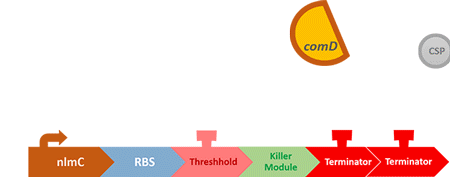Team:NYMU-Taipei/project/1c
From 2014.igem.org
Here’s the Gist…
- We incorporate our circuit into Streptococcus phage M102. The phage-infected Streptococcus mutans emit quorum-sensing signal will pass the message down to our probiotics terminus then trigger the S. mutans killing module of it.
Get started.
How to do it?
Test it!
Our result~
Reference
Before we get started:
The "control part" is going to control the number of S. mutans. When the number of S. mutans exceeds the threshold that causes cavities, the circuit will be activated, thus killing the excess S. mutans.
In order to find and confirm the threshold that causes cavities, we designed different kinds and numbers of terminators (each with different leakage rates) to create the threshold. Moreover, we combined both wet lab results and modelling to decide which design is more suitable.
Over the years, it has been found that the competence stimulating peptide, CSP, a quorum sensing chemical, is released in every competence S. mutans. Thus, we can detect the number of S. mutans by marking the amount of CSP.
In S. mutans the CSP bind to the membrane receptor, "comD", thereby phosphorylating the response regulator, "comE". The phosphorylated comE will activate numerous vital biological mechanisms in Streptococcus mutans such as biofilm formation and the release of mutacin, an antibiotic peptide. Compared with all the other mechanisms involved with CSP, it is found that the promoter of gene "nlmC"( non-lantibiotic mutacin C) in S. mutans has the best performance under the stimulation of CSP.

So how did we do it?
Putting it to the test!
Our result
Reference
- http://www.expertsmind.com/topic/microbiology/bacterial-cell-wall-92313.aspx
 "
"




















